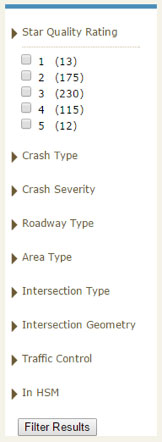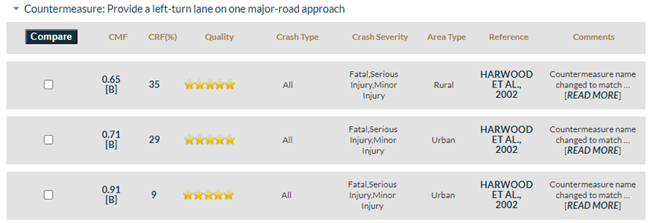Identifying Appropriate CMFs
How do I Interpret Search Results?
 Filtering Search Results
Filtering Search Results
The search results page provides filters on the left side to enable users to narrow the search results to eliminate CMFs whose details do not match the conditions of the site of interest. For example, if a user is searching for a CMF to use at an urban intersection, the user may use the area type filter to remove all rural CMFs from the displayed results.
To use the filters, a user simply expands the filter using the small triangle, checks one or more boxes, and clicks “Filter Results”. The search results page will reload, showing a smaller group of the previous results that meet the selected criteria. If a CMF has multiple values in the field being filtered (e.g., CMF for crash types of Angle and Left Turn), it will show up in the filtered results as long as one of the crash types is checked. The numbers in parentheses within each filter option indicate how many CMFs from the search have that characteristic.
See the video below for a demonstration on how to use the search results filters to narrow down a large set of search results.
Understanding the Star Rating
![]()
The star rating indicates the quality or confidence in the results of the study producing the CMF. The star rating is based on a scale (1 to 5), where a 5 indicates the highest or best rating. The review process to determine the star rating judges the accuracy and precision as well as the general applicability of the study results. The Clearinghouse team considers various factors for each study (depending on the study type used to develop the CMFs) – study design, sample size, statistical methodology, statistical significance, etc. – and judges each CMF according to its performance across various factors (including multiple subcategories within each factor). Read more detailed information on the star quality rating system.
How do I select the most appropriate CMF?
A search for CMFs will often return multiple results, sometimes hundreds of CMFs. Even after identifying a particular countermeasure of interest, a user must often make a decision about which CMF under that countermeasure to select and use.
Selecting a CMF by Matching on Major Factors
The primary goal is to select a CMF that was developed under the same conditions as the site of interest to which it will be applied. A user must examine the information related to the applicability of the CMFs to determine how they differ. Some major characteristics are shown on the search results page (i.e., crash type, crash severity, roadway type, and area type). More characteristics can be seen by viewing the CMF details page.
See the video below for an example of a CMF details page and learn what each piece of information means and why it is important.
The user should select the CMF that is most applicable to the situation in which it will be applied. That is, the major characteristics associated with the CMF (e.g., crash type, crash severity, intersection or roadway type) should closely match the characteristics of the scenario at hand. The figure below shows a snapshot of results for the countermeasure of "Installation of left-turn lane on single major road approach". The three CMFs listed in this figure all have 5-star ratings. However, the CMF values (0.65, 0.71, and 0.91) are all different.

From this initial view of the search results, it is relatively easy to tell the difference between the first CMF and the other two. Although all three are similar in crash type and crash severity, the first one (CMF of 0.65) is identified as being developed for a "Rural" area type, whereas the other two were developed for an "Urban" area type.
However, all information given on the search results page is identical for the second and third CMF. Therefore, it is necessary to examine the details of each CMF (by clicking on the CMF value to go to the CMF details page). When the details of each CMF are examined, it can be seen that the CMF of 0.71 is intended for stop-controlled intersections, and the CMF of 0.91 is intended for signalized intersections.
Selecting a CMF when Major Factors are the Same
It may be the case that multiple CMFs are exactly the same with respect to crash and roadway or intersection applicability. In these cases, it will be necessary to examine some of the other fields to decide which CMF to use:
- Star quality rating – The star quality rating reflects the reliability of the CMF, based on five criteria: study design, sample size, standard error, potential bias, and data source. If a user is considering two or more CMFs that are the same on all major factors (e.g., crash type, crash severity, etc.), the star quality rating can be used to indicate which CMF is the highest quality and therefore should be selected. More stars means higher quality. Some departments of transportation have set “minimum acceptable” star rating thresholds. However, the CMF Clearinghouse does not make any recommendation to this effect.
- Score details – The star quality rating is established consists of scores for various factors (depending on the study type used to develop the CMFs) – study design, sample size, statistical methodology, statistical significance, etc. Many CMFs in the Clearinghouse are accompanied by details of the scores behind the star rating. Clicking on the "View score details" link will display a window showing the scores that the CMF received in each category. Users of the Clearinghouse may desire to examine the score details to compare two or more similar CMFs. For instance, although two CMFs may have received the same star rating, one may have used a large sample size while the other may have used a smaller sample size. It may be the case that a user may highly value a certain factor and may use that to decide between CMFs.
- Similarity in locality of data used – The fields for "Municipality", "State", and "Country" indicate the area(s) from which data were used in developing the CMF. Many agencies prefer CMFs that were developed in locations that are similar or nearby to their own area, for reasons of terrain, weather, and other characteristics. For example, a state department of transportation in a mid-western state may prefer using a CMF developed in Kansas over a CMF developed in West Virginia.
- Traffic volume range – The fields for "Major Road Traffic Volume" and "Minor Road Traffic Volume" indicate the range of traffic volumes that were used to develop the CMF. Users should examine these fields to see which CMF has a traffic volume range that best fits the site of interest.
- Age of data – The field for "Date Range of Data Used" on the CMF details page indicates the age of the data used in developing the CMF. Generally speaking, more recent data would be preferred (all other factors being equal). Studies conducted more recently typically use more advanced techniques, higher precision data, and have other advantages related to the progression of knowledge, data quality, and study methods that develop over time in the field of highway safety research. More recent data will also better reflect changes in vehicle fleet characteristics and technology.
- Original study report – In addition to providing the citation of the study, the Clearinghouse provides a link, where possible, to the original study document for any CMF. This original document will typically be the final report or published article on the study that developed the CMF. A user of the Clearinghouse who is attempting to select between two similar CMFs may find it useful to refer to the original study report to understand the background of the CMF development. There may be details in the study report that would assist in the CMF selection process. Although the Clearinghouse contains extensive data for each CMF, it does not contain every detail from the study report. For example, the report may discuss details about the roadside character of the roads used in the CMF development. If the roadside character is significantly different from the roads in the user's jurisdiction, he or she may decide to select another CMF that was developed on roads with more similar roadside character to his or her jurisdiction.
Users interested in more information about assessing the quality and usability of CMFs may be interested in the Science of Crash Modification Factors course. The course covers the concepts underlying the measurement of safety and the development of CMFs, the key statistical issues that affect the development of quality CMFs, the key methodological issues that affect the development of quality CMFs, and the general and methodological issues and statistical thresholds used to recognize quality CMFs.
How can I submit CMFs to be included on the Clearinghouse?
Any CMF Clearinghouse user can submit a study to be reviewed by the Clearinghouse team for potential inclusion in the Clearinghouse. The top navigation bar provides a link to “Submit CMFs ”. The submitted study will be reviewed during the next review cycle.

